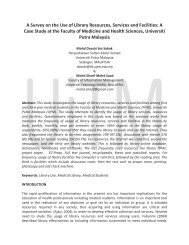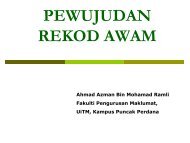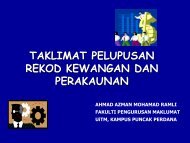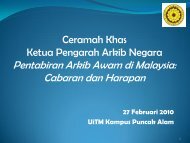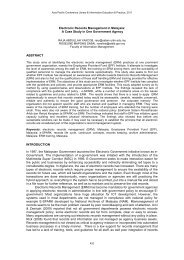Service Quality and User Satisfaction of the Reader's Advisory Desk ...
Service Quality and User Satisfaction of the Reader's Advisory Desk ...
Service Quality and User Satisfaction of the Reader's Advisory Desk ...
You also want an ePaper? Increase the reach of your titles
YUMPU automatically turns print PDFs into web optimized ePapers that Google loves.
LITERATURE REVIEWThe literature on SERVQUAL is very wide as it has been used for measuring service qualitythat is usually measured <strong>and</strong> used in many industries such as marketing, hotel industry, retailindustry, library service, <strong>and</strong> o<strong>the</strong>rs. SERVQUAL was introduced in 1988 by A. Parasuraman,Valarie A. Zeitham <strong>and</strong> Leonard L. Berry. It is an instrument for assessing customerperceptions <strong>of</strong> service quality in service <strong>and</strong> retailing organizations (Parasuraman, A. et al.,1988). Many studies have established that service quality <strong>and</strong> user satisfaction areinterrelated. According to Wang, Ming-I <strong>and</strong> Sheih, Chich-Jen (2006), in <strong>the</strong>ir study <strong>of</strong> <strong>the</strong>relationship between service quality <strong>and</strong> customer satisfaction, it was found that generallyservice quality has significantly positive effects on <strong>the</strong> overall user satisfaction. Therefore, aneffort undertaken to improve service quality is to provide service that meet user’sexpectations <strong>and</strong> satisfy <strong>the</strong>ir needs.Zaherawati Zakaria, et al. (2009), study found that <strong>the</strong>re is significant relationship betweenservice quality <strong>and</strong> reliability, as well as responsiveness, i.e. dimensions <strong>of</strong> service qualitymeasures which have strong positive relationship; <strong>and</strong> tangible dimension which has fairlystrong positive relationship. Besides that <strong>the</strong>y also found that <strong>the</strong> attitudes <strong>and</strong> willingness<strong>of</strong> librarians have indeed significant relationship with <strong>the</strong> service quality. According toBicknell (1994), many previous reference studies have assumed that a user’s primary need isto receive an accurate answer. “An accurate answer” is also included in <strong>the</strong> reliabilitydimension in SERVQUAL. Bicknell said that <strong>the</strong>re are four main aspects in assessing <strong>the</strong>quality <strong>of</strong> reference work, that is, i) user needs <strong>and</strong> expectations, ii) staff behaviors <strong>and</strong>communication skills, iii) <strong>the</strong> reference environment, <strong>and</strong> iv) staff morale <strong>and</strong> workload.Zabed Ahmad <strong>and</strong> Mohd Zahid Hossain Shoeb (2009) had used a SERVQUAL-basedquestionnaire to evaluate <strong>the</strong> public university library in Bangladesh, which is <strong>the</strong> DhakaUniversity Library. The findings revealed that <strong>the</strong> attitudes <strong>of</strong> <strong>the</strong> librarians during <strong>the</strong> userlibrarianconsultation session contributes to <strong>the</strong> user satisfaction <strong>and</strong> <strong>the</strong> extent <strong>of</strong> <strong>the</strong>frequency <strong>of</strong> <strong>the</strong> consultations between <strong>the</strong> user <strong>and</strong> <strong>the</strong> reference librarians. The findingsconfirmed that overall user satisfaction is based on <strong>the</strong> quality <strong>of</strong> services <strong>of</strong>fered to <strong>and</strong>received by <strong>the</strong> users, as well as <strong>the</strong> perception <strong>of</strong> users’ satisfaction towards <strong>the</strong>performance <strong>of</strong> <strong>the</strong> librarians <strong>of</strong>fering <strong>the</strong> services.METHODOLOGYStudy Population <strong>and</strong> Sampling DesignSince <strong>the</strong> objective <strong>of</strong> <strong>the</strong> study is to identify <strong>the</strong> effectiveness <strong>of</strong> <strong>the</strong> Reader’s <strong>Advisory</strong> <strong>Desk</strong><strong>Service</strong> practice in <strong>the</strong> UPM Library, <strong>the</strong> study population consisted <strong>of</strong> <strong>the</strong> users who haveposed <strong>the</strong> enquiries (i.e. reference questions <strong>and</strong> problems) to <strong>the</strong> reader’s advisor on dutyat <strong>the</strong> Reader’s <strong>Advisory</strong> <strong>Desk</strong> <strong>Service</strong>, or <strong>the</strong> persons/users who have been identified asfrequent users <strong>of</strong> <strong>the</strong> Reader’s <strong>Advisory</strong> <strong>Desk</strong> <strong>Service</strong>. The purposive sampling / judgmentsampling is confined to specific types <strong>of</strong> people or specific target groups who can provide <strong>the</strong>desired information.
2.5% (n=1) responded to o<strong>the</strong>rs. Meanwhile 10% (n=4) <strong>of</strong> <strong>the</strong> respondents who chose morethan one responses said that <strong>the</strong>y always ask for help finding articles/help using databasesor e-journals / wanted to save time. Only 5% (n=2) chose <strong>the</strong> response <strong>of</strong> help findingarticles / help using databases or e-journal, while 2.5% (n=1) respondents each chose acombination <strong>of</strong> <strong>the</strong> items stated in <strong>the</strong> questionnaire.Reliability <strong>of</strong> Reader’s <strong>Advisory</strong> <strong>Desk</strong> <strong>Service</strong>Reliability <strong>of</strong> service has a positively significant relationship with <strong>the</strong> quality <strong>of</strong> <strong>the</strong> Reader’s<strong>Advisory</strong> <strong>Desk</strong> <strong>Service</strong>. The research findings showed that a majority <strong>of</strong> users are satisfiedwith <strong>the</strong> Reader’s <strong>Advisory</strong> <strong>Desk</strong> <strong>Service</strong> which is considered to have been <strong>of</strong>fered withreliability. All respondents perceived <strong>the</strong> effectiveness <strong>of</strong> <strong>the</strong> Reader’s <strong>Advisory</strong> <strong>Desk</strong> <strong>Service</strong>by <strong>the</strong> positive response provided. As shown in figure 1, most <strong>of</strong> <strong>the</strong> respondents were ableto find reliable information every time <strong>the</strong>y pose enquiries (questions or problems) <strong>and</strong> thisrepresents 57.5% (n=23), followed by all <strong>of</strong> <strong>the</strong>m or 25% (n=10) were able to find reliableinformation every time <strong>the</strong>y pose enquiries (questions or problems), while only some <strong>of</strong><strong>the</strong>m or 17.5% (n=7) were able to find reliable information every time <strong>the</strong>y pose enquiries(questions or problems. The outcome <strong>of</strong> such findings was supported by <strong>the</strong> interest <strong>of</strong> <strong>the</strong>reader advisor in solving <strong>the</strong> enquiries posed (questions or problems). As indicated in figure2, 60% (n=24) <strong>of</strong> <strong>the</strong> reader advisors were always able to answer most <strong>of</strong> <strong>the</strong> respondents’enquiries (questions or problems) correctly, followed by 37.5% (n=15) were <strong>of</strong>ten able toanswer most <strong>of</strong> <strong>the</strong> respondents’ enquiries (questions or problems) correctly, <strong>and</strong> only 2.5%(n=1) were not very <strong>of</strong>ten able to answer most <strong>of</strong> <strong>the</strong> respondents’ enquiries (questions orproblems) correctly.Besides that, <strong>the</strong> reader advisors also correctly <strong>and</strong> accurately advised <strong>the</strong> students on howto get started with <strong>the</strong>ir research, <strong>and</strong> <strong>the</strong>y were reliable in <strong>the</strong>ir teaching on how to access,evaluate <strong>and</strong> use information. 55% (n=22) <strong>of</strong> respondents responded that <strong>the</strong> readeradvisors very <strong>of</strong>ten advised <strong>and</strong> teach <strong>the</strong>m about access, evaluating <strong>and</strong> using information,followed by 35% (n=14) responded <strong>of</strong>ten that <strong>the</strong> reader advisors advise <strong>and</strong> teach <strong>the</strong>mabout access, evaluating <strong>and</strong> using information, <strong>and</strong> only 10% (n=4) <strong>of</strong> <strong>the</strong>m responded notvery <strong>of</strong>ten that <strong>the</strong> reader advisors advise <strong>and</strong> teach <strong>the</strong>m about access, evaluating <strong>and</strong>using information.Responsiveness <strong>of</strong> Reader’s <strong>Advisory</strong> <strong>Desk</strong> <strong>Service</strong>With regards to <strong>the</strong> aspect <strong>of</strong> <strong>the</strong> responsiveness <strong>of</strong> Reader’s <strong>Advisory</strong> <strong>Desk</strong> <strong>Service</strong>, asshown in figure 3, respondents perceived that 62.5% (n=25) <strong>of</strong> <strong>the</strong> reader advisors arewilling to help <strong>the</strong>m, 32.5% (n=13) responded that most <strong>of</strong> <strong>the</strong> reader advisors are willing tohelp <strong>the</strong>m, while only 5% (n=2) responded that some <strong>of</strong> <strong>the</strong> reader advisors have attendedto <strong>the</strong>ir enquiries with a response time <strong>of</strong> within 1-15 minute. The higher percent <strong>of</strong>response time within 1-15 minutes is very much dependent on <strong>the</strong> kind <strong>of</strong> questions posed.UPM reader advisors have a high level <strong>of</strong> responsiveness, <strong>and</strong> this finding support <strong>the</strong>outcome that all users have positively responded that <strong>the</strong> reader advisors are active inproviding <strong>the</strong> service.As indicated in figure 4, 60% (n=24) <strong>of</strong> respondents strongly agreed <strong>and</strong> 32.5% (n=13) agree
that <strong>the</strong> reader advisors have <strong>the</strong> ability to answer all enquiries (questions or problems)posed to <strong>the</strong>m, while 5% (n=2) have answered disagreed with 2.5% (n=1) answered not sureas <strong>the</strong>ir response. This is supported by <strong>the</strong> RUSA Reference Guideline (2004) which statesthat librarians who demonstrate a high level <strong>of</strong> interest in <strong>the</strong> inquiries <strong>of</strong> <strong>the</strong>ir patrons willgenerate a higher level <strong>of</strong> satisfaction among users. Accordingly, all reader advisors in <strong>the</strong>UPM library are active in provides services, <strong>and</strong> that this is supported by <strong>the</strong> correlation <strong>of</strong>coefficient which is significant at <strong>the</strong> 2-tailed. Only one attribute that is reliability: answerquestions correctly significant at 1-tailed, which showed that even if a reader advisor doesnot answer questions correctly, but is friendly <strong>and</strong> willingly helpful, <strong>the</strong> users will still besatisfied <strong>and</strong> are most likely continue to use <strong>the</strong> Reader’s <strong>Advisory</strong> <strong>Desk</strong> service.Assurance <strong>and</strong> Reader’s <strong>Advisory</strong> <strong>Desk</strong> <strong>Service</strong>On <strong>the</strong> aspect <strong>of</strong> providing information material, <strong>the</strong> reader advisors are viewed as efficientin providing relevant materials from <strong>the</strong> library collection, as none <strong>of</strong> <strong>the</strong> respondentsselected inefficient as <strong>the</strong>ir response. The majority <strong>of</strong> respondents i.e. 60% (n=24) held that<strong>the</strong> reader advisor is efficient in providing relevant materials from <strong>the</strong> library collection,followed by very efficient being <strong>the</strong> response <strong>of</strong> 40% (n=16) <strong>of</strong> <strong>the</strong> respondents. Whenapproaching users with <strong>the</strong>ir information needs, <strong>the</strong> reader advisors are equipped with <strong>the</strong>necessary skills <strong>and</strong> ability to ask <strong>and</strong> probe <strong>the</strong> users with appropriate questions in order toget to <strong>the</strong> exact information <strong>the</strong>y needed. It is found that 52.5% (n=21) <strong>of</strong> <strong>the</strong> readeradvisors frequently ask questions to determine <strong>the</strong> exact information that <strong>the</strong> users need,followed by 42.5% (n=17) most frequently <strong>and</strong> only 5% (n=2) responded less frequently.All users are satisfied with <strong>the</strong> Reader’s <strong>Advisory</strong> <strong>Desk</strong> service that were <strong>of</strong>fered withassurance because <strong>the</strong> majority <strong>of</strong> <strong>the</strong> reader advisors have <strong>the</strong> knowledge to answer <strong>the</strong>questions <strong>and</strong> possess <strong>the</strong> skills to find <strong>and</strong> retrieve <strong>the</strong> correct answers. Majority <strong>of</strong> <strong>the</strong>respondents i.e. 55% (n=22) responded very <strong>of</strong>ten to <strong>the</strong> aspect <strong>of</strong> <strong>the</strong> reader advisors’awareness <strong>of</strong> every service provided by <strong>the</strong> library, followed by <strong>of</strong>ten 40% (n=16), <strong>and</strong> only5% (n=2) not very <strong>of</strong>ten <strong>and</strong> none responded not at all. This result indicates <strong>the</strong> knowledgethat <strong>the</strong> reader advisors possess <strong>and</strong> <strong>the</strong> ability to answer <strong>the</strong> questions is significant touser satisfaction. This is proven in this study, that <strong>the</strong> positive responses are directly relatedwith <strong>the</strong> knowledge <strong>of</strong> <strong>the</strong> reader advisors. A majority <strong>of</strong> <strong>the</strong>m have <strong>the</strong> knowledge toanswer <strong>the</strong> questions that were posed by <strong>the</strong> users to <strong>the</strong>m. This was evidenced by 52.5%(n=21) <strong>of</strong> respondents who strongly agreed, with 42.5% (n=17) agreed that <strong>the</strong> readeradvisors are knowledgeable <strong>and</strong> skillful thus leading to <strong>the</strong>ir satisfaction being fulfilled,while only 5% (n=2) disagree.Empathy <strong>and</strong> Reader’s <strong>Advisory</strong> <strong>Desk</strong> <strong>Service</strong>50% (n=20) <strong>of</strong> <strong>the</strong> respondents know that <strong>the</strong> reader advisors are <strong>of</strong>ten available at <strong>the</strong>Reader’s <strong>Advisory</strong> <strong>Desk</strong> while very <strong>of</strong>ten available was indicated by 47.5% (n=19) <strong>of</strong> <strong>the</strong>respondents <strong>and</strong> only 2.5% (n=1) <strong>of</strong> <strong>the</strong>m are not sure, hence <strong>the</strong>y did not need to be inlong queues or wait for very long. This is supported by <strong>the</strong> findings which showed 50 %(n=20) <strong>of</strong> <strong>the</strong> respondents have not been kept waiting in <strong>the</strong> long queue at all, followed bynot very <strong>of</strong>ten 32.5% (n=13). This is because at certain times <strong>the</strong> Reader’s <strong>Advisory</strong> <strong>Desk</strong>may be staffed by two librarians, particularly during peak periods <strong>of</strong> use, for example in <strong>the</strong>
new semester, while only 17.5% (n=7) had responded <strong>of</strong>ten, <strong>and</strong> 2.5% (n=1) had respondednot sure. Occasionally <strong>the</strong>y still need to wait particularly when <strong>the</strong> response time is morethan <strong>the</strong> expected, more over for <strong>the</strong> new students. Majority <strong>of</strong> <strong>the</strong> respondents agree <strong>the</strong>opening <strong>and</strong> closing hours <strong>of</strong> <strong>the</strong> Reader’s <strong>Advisory</strong> <strong>Desk</strong> service is convenient <strong>and</strong> ideal for<strong>the</strong>m, as evidenced by 55% (n=22) who responded agree, 35% (n=14) strongly agree, while10% (n=4) disagree. Most <strong>of</strong> <strong>the</strong> respondents i.e. 52.5% (n=21) strongly agree that <strong>the</strong>reader advisors are never busy to respond to <strong>the</strong>ir information needs while 45% (n=18)agree with only 2.5% (n=1) disagree.Tangible <strong>and</strong> Reader’s <strong>Advisory</strong> <strong>Desk</strong> <strong>Service</strong>Based on <strong>the</strong> results, majority <strong>of</strong> <strong>the</strong> respondents, representing 52.5%, (n=21) stronglyagreed that <strong>the</strong> Reader’s <strong>Advisory</strong> <strong>Desk</strong> in <strong>the</strong> UPM library are ready with modern facilities<strong>and</strong> equipment, followed by 47.5% (n=19) agreed while none <strong>of</strong> <strong>the</strong> respondents hadresponded disagreed <strong>and</strong> strongly disagreed. This result illustrates that <strong>the</strong>y consider <strong>the</strong>facilities <strong>and</strong> equipment are well-suited <strong>and</strong> <strong>the</strong> chairs provided at <strong>the</strong> Reader’s <strong>Advisory</strong><strong>Desk</strong> to be comfortable with 55% (n=22) <strong>of</strong> <strong>the</strong>m responded to very convenient, followedby 45% (n=18) convenient while none <strong>of</strong> <strong>the</strong>m selected inconvenient.Respondents’ Perception <strong>of</strong> <strong>the</strong> Reader’s <strong>Advisory</strong> <strong>Desk</strong> <strong>Service</strong>With regards to <strong>the</strong> overall perception <strong>of</strong> <strong>the</strong> Reader’s <strong>Advisory</strong> <strong>Desk</strong> service, most <strong>of</strong>respondents, representing 65% (n=26) are very satisfied <strong>and</strong> 35% (n=14) are satisfied, <strong>and</strong>none <strong>of</strong> <strong>the</strong>m are dissatisfied with this service. Based on this result, it can be concluded that<strong>the</strong> Reader’s <strong>Advisory</strong> <strong>Desk</strong> service <strong>of</strong> <strong>the</strong> UPM library has been successful in its delivery <strong>of</strong>this service to <strong>the</strong> users <strong>and</strong> able to achieve its mission <strong>of</strong> providing <strong>the</strong> best service at <strong>the</strong>Reader’s <strong>Advisory</strong> <strong>Desk</strong> with ≥85% <strong>of</strong> <strong>the</strong> users who are satisfied with <strong>the</strong> services provided(Reference <strong>Service</strong> Manual <strong>Quality</strong>.UPM/PSAS/MK, 2008). Based on this finding also, it isevident that <strong>the</strong> SERVQUAL dimensions were implemented <strong>and</strong> applied to provide goodquality service at <strong>the</strong> Reader’s <strong>Advisory</strong> <strong>Desk</strong> <strong>of</strong> <strong>the</strong> UPM library. This demonstrates that <strong>the</strong>quality <strong>of</strong> <strong>the</strong> services that were <strong>of</strong>fered with <strong>the</strong> added dimensions <strong>of</strong> reliability, assurance,responsiveness, empathy <strong>and</strong> tangible does have direct effect on user satisfaction.On <strong>the</strong> question <strong>of</strong> future return visits to <strong>the</strong> Reader’s <strong>Advisory</strong> <strong>Desk</strong> to ask for assistanceabout questions/problems, majority <strong>of</strong> respondents or 60% (n=24) responded that <strong>the</strong>ywould definitely return <strong>and</strong> 40% (n=16) would likely return, while none <strong>of</strong> <strong>the</strong>m would notlikely return or definitely would not return. This confirms that <strong>the</strong>y like <strong>and</strong> happy with thisservice <strong>and</strong> <strong>the</strong>y perceive this service as very helpful, very supportive, thus proving that <strong>the</strong>Reader’s <strong>Advisory</strong> <strong>Desk</strong> service <strong>of</strong> <strong>the</strong> UPM library has been effective <strong>and</strong> efficient inproviding <strong>the</strong> services.DISCUSSION AND CONCLUSIONFrom <strong>the</strong> findings, more postgraduate students frequently <strong>and</strong> actively used <strong>the</strong> Reader’s<strong>Advisory</strong> <strong>Desk</strong> <strong>Service</strong> with <strong>the</strong>ir questions <strong>and</strong> enquiries for information <strong>and</strong> relevantresources that were needed in preparing for <strong>the</strong>ir <strong>the</strong>ses. Essentially, <strong>the</strong>y need assistanceto identify <strong>and</strong> locate current journal articles or research articles in areas related to <strong>the</strong>irsubject interests. Postgraduate students are found to be <strong>the</strong> more frequent users <strong>of</strong> this
service <strong>and</strong> this can be associated to <strong>the</strong>ir awareness <strong>of</strong> <strong>the</strong> functions <strong>of</strong> <strong>the</strong> Reader’s<strong>Advisory</strong> <strong>Desk</strong> service. Besides that, <strong>the</strong>ir level <strong>of</strong> maturity as postgraduate students make<strong>the</strong>m more likely to be informed users <strong>of</strong> <strong>the</strong> library <strong>and</strong> <strong>the</strong> services <strong>of</strong>fered.As for <strong>the</strong> first year <strong>and</strong> second year undergraduate users who frequent <strong>the</strong> Reader’s<strong>Advisory</strong> <strong>Desk</strong> for its services, it can be deduced that being new students, <strong>the</strong>y need t<strong>of</strong>amiliarize <strong>the</strong>mselves with <strong>the</strong> library, its facilities <strong>and</strong> <strong>the</strong> various resources available. Theyneed to be trained on how to access <strong>and</strong> retrieve <strong>the</strong> library resources <strong>and</strong> materialsthrough <strong>the</strong> use <strong>of</strong> <strong>the</strong> WEBOPAC <strong>and</strong> various subscribed database.Based on this study, it is found that <strong>the</strong> respondents always ask questions/ pose problemsrelating <strong>the</strong> use <strong>of</strong> online databases. For example, <strong>the</strong>y need help, using <strong>the</strong> databases or e-journals to identify, locate <strong>and</strong> find relevant articles as <strong>the</strong>y occasionally face such problemsas accessing <strong>the</strong> full text documents, or downloading full text articles, or selectingappropriate databases to retrieve relevant articles for <strong>the</strong>ir work. They also need assistanceto locate full text articles when <strong>the</strong> journals are not subscribed by <strong>the</strong> library, or to requestfor articles from o<strong>the</strong>r universities through <strong>the</strong> interlibrary loan service, or to obtain printedjournals. Many students also face a common problem <strong>of</strong> remote access to online databasesfrom <strong>of</strong>f-campus locations, i.e. not being able to download full text articles. Majority <strong>of</strong>students request for information from online databases as <strong>the</strong>ir focus <strong>of</strong> attention is mainlyon retrieving information from online databases or e-journals only since <strong>the</strong>y are unawarethat <strong>the</strong> library also subscribes to printed journals.The number <strong>of</strong> users who asked questions or posed problems to, or required <strong>the</strong> services <strong>of</strong><strong>the</strong> UPM Library Reader’s <strong>Advisory</strong> <strong>Desk</strong> from January - December 2009, revealed that <strong>the</strong>highest number <strong>of</strong> questions are regarding use <strong>of</strong> <strong>the</strong> OPAC <strong>and</strong> online databasesrepresented by 4855 enquiries for OPAC <strong>and</strong> 3532 enquiries for online databases. FromJanuary – December 2010, 5048 for OPAC <strong>and</strong> 3774 enquiries were for online databases.Overall 15, 080 users in year 2009 <strong>and</strong> 16, 173 users in year 2010 had asked questions orposed problems to, or had required <strong>the</strong> services, <strong>of</strong> <strong>the</strong> UPM Library Reader’s <strong>Advisory</strong> <strong>Desk</strong>(Sultan Abdul Samad Library, 2010). Based on <strong>the</strong>se statistics, it can be assumed that <strong>the</strong>user education programs were not effective in educating <strong>and</strong> training students in <strong>the</strong> use <strong>of</strong><strong>the</strong> OPAC <strong>and</strong> online databases. As a result, users keep asking questions or problems atReader’s <strong>Advisory</strong> <strong>Desk</strong> service. On <strong>the</strong> o<strong>the</strong>r h<strong>and</strong>, <strong>the</strong> users <strong>the</strong>mselves may not haveattended all <strong>the</strong> user education programs provided by <strong>the</strong> library’s InformationManagement Unit due to a clash <strong>of</strong> <strong>the</strong>ir class time table with <strong>the</strong> schedules <strong>of</strong> <strong>the</strong> usereducation programs; or due to o<strong>the</strong>r reasons. Fur<strong>the</strong>rmore, <strong>the</strong> lack <strong>of</strong> concerted efforts topromote <strong>the</strong>se programs to users is a contributing factor as to why users did not/cannotattend <strong>the</strong>se user education programs/training sessions which result in <strong>the</strong> users beinguninformed <strong>of</strong> such activities. It suggested that library’s Information Management Unit,need to critically think about designing an interesting, captivating <strong>and</strong> useful trainingmodule/program that enables <strong>the</strong> users to use <strong>the</strong> library effectively, allows <strong>the</strong>m to beinformed about various library services <strong>and</strong> facilities as well resources available, <strong>and</strong>improves on <strong>the</strong> users’ information literacy skills including <strong>the</strong> use <strong>of</strong> <strong>the</strong> OPAC <strong>and</strong> onlinedatabases. Promotions should be aggressively carried out to ensure that all users are madeaware <strong>of</strong> any program to be held so that <strong>the</strong>y are able to fit <strong>the</strong>se training programs into<strong>the</strong>ir schedules. This unit should also try <strong>the</strong>ir level best to align <strong>the</strong>ir training programs toassure maximum student attendance.
Reliability <strong>of</strong> service has positively significant relationship with quality <strong>of</strong> Reader’s <strong>Advisory</strong><strong>Desk</strong> service. Based on <strong>the</strong> findings, majority <strong>of</strong> users are satisfied with <strong>the</strong> Reader’s<strong>Advisory</strong> <strong>Desk</strong> service <strong>of</strong>fered with high level <strong>of</strong> reliability <strong>and</strong> <strong>the</strong> positive response from allrespondents had indicated that <strong>the</strong>y perceived <strong>the</strong> Reader’s <strong>Advisory</strong> <strong>Desk</strong> service waseffective. As shown in figure 1 <strong>and</strong> 2, 60% (n=24) <strong>of</strong> <strong>the</strong> respondents said that <strong>the</strong> readeradvisors very <strong>of</strong>ten answered all <strong>the</strong> questions accurately <strong>and</strong> correctly <strong>and</strong> 57.5% (n=23) <strong>of</strong><strong>the</strong>m were able to get reliable information from <strong>the</strong> reader advisors. From <strong>the</strong> dataanalyzed, all reader advisors have been able to provide <strong>the</strong> advisory service to <strong>the</strong>satisfaction <strong>of</strong> <strong>the</strong> users, were able to answering questions accurately <strong>and</strong> correctly, wereable to give <strong>the</strong>m precise information that enabled <strong>the</strong> users to use <strong>the</strong> relevant sources <strong>of</strong>information. It showed that all <strong>the</strong> reader advisors were able to function as effectivereference <strong>of</strong>ficers, even though some <strong>of</strong> <strong>the</strong>m are just semi-pr<strong>of</strong>essional level personnel.On <strong>the</strong> question <strong>of</strong> responsiveness <strong>of</strong> <strong>the</strong> Reader’s <strong>Advisory</strong> <strong>Desk</strong> service, <strong>the</strong> respondentsperceived that <strong>the</strong> reader advisors were always willing to help users, with <strong>the</strong> higherpercentage <strong>of</strong> response time within 1-15 minutes, depending on <strong>the</strong> level <strong>of</strong> difficulty <strong>of</strong> <strong>the</strong>questions asked/posed to <strong>the</strong>m. As shown in figure 4, majority <strong>of</strong> <strong>the</strong> respondents stronglyagreed as well as agreed that <strong>the</strong> reader advisors were very active in providing <strong>the</strong> service,<strong>and</strong> this shows that <strong>the</strong> reader advisors spent a great deal <strong>of</strong> time to ensure that <strong>the</strong>ir usersget accurate, reliable <strong>and</strong> correct information to support <strong>the</strong>ir information needs. Thereader advisors utilized a variety <strong>of</strong> approaches <strong>and</strong> multiple alternative ways to track <strong>the</strong>relevant information resources. For instance, <strong>the</strong> reader advisors may use A to Z full text e-journals, identify UPM library’s subscribed journals <strong>and</strong> its coverage, search article titlesusing Scopus, check <strong>the</strong> library’s OPAC to identify printed journals or o<strong>the</strong>r resources in <strong>the</strong>library’s collections. In addition, <strong>the</strong>y also check o<strong>the</strong>r libraries’ OPACs to identify resourcesfor inter-library loan purpose. Sometimes, <strong>the</strong> reader advisors are also required to explain<strong>the</strong> uses <strong>of</strong> certain reference tools, such as Refwork for preparing bibliographic citations, orTurnitin s<strong>of</strong>tware for detecting plagiarism. One major problem that may affect <strong>the</strong> swiftness<strong>of</strong> <strong>the</strong> response time when <strong>the</strong> reader advisors respond to <strong>the</strong> users’ information needswould be <strong>the</strong> Internet. Often times <strong>the</strong> Internet was slow <strong>and</strong> sluggish, <strong>and</strong> this affected <strong>the</strong>response time <strong>and</strong> <strong>the</strong> overall services.Assurance <strong>of</strong> service has positively significant relationship with <strong>the</strong> quality <strong>of</strong> <strong>the</strong> Reader’s<strong>Advisory</strong> <strong>Desk</strong> service. In <strong>the</strong> assurance <strong>of</strong> services, <strong>the</strong> reader advisors were efficient inproviding relevant materials from <strong>the</strong> library collections, as none <strong>of</strong> <strong>the</strong> respondents choseinefficient in <strong>the</strong>ir response. The reader advisors showed <strong>the</strong>ir capability in h<strong>and</strong>ling <strong>the</strong>irusers’ information needs by approaching <strong>and</strong> questioning <strong>the</strong>m as to <strong>the</strong> exact nature <strong>of</strong><strong>the</strong> information that <strong>the</strong>y needed. It is found that 52.5% (n=21) <strong>of</strong> <strong>the</strong> reader advisorsfrequently asked questions regarding <strong>the</strong> exact information needed, followed by 42.5%(n=17) most frequently. The result for less frequently is only 5% (n=2) <strong>and</strong>, this could beattributed to some communication difficulties particularly involving <strong>the</strong> internationalstudents. Communication difficulties posed ano<strong>the</strong>r major problem for <strong>the</strong> internationalstudents. The reader advisors experienced difficulty in comprehending <strong>the</strong>se foreignstudents because <strong>of</strong> variations in <strong>the</strong>ir pronunciation or intonation. It could also be a result<strong>of</strong> <strong>the</strong> students’ inability to express <strong>the</strong>ir information needs clearly due to <strong>the</strong>ir lack <strong>of</strong>fluency in <strong>the</strong> language with vocabulary limitations, or lack self-confidence in using <strong>the</strong>language <strong>and</strong> may be timid in <strong>the</strong> use <strong>of</strong> <strong>the</strong> language such as not being able to express
<strong>the</strong>mselves adequately.The UPM library Reader’s <strong>Advisory</strong> <strong>Desk</strong> service is <strong>of</strong>fered with assurance because majority<strong>of</strong> <strong>the</strong> reader advisors have <strong>the</strong> knowledge to provide resources as well as <strong>the</strong> answers to<strong>the</strong> users’ questions, <strong>and</strong> <strong>the</strong>y possess <strong>the</strong> required skills to obtain <strong>and</strong> retrieve <strong>the</strong> accurateresources <strong>and</strong> answers. This study also confirmed that <strong>the</strong> knowledge <strong>and</strong> skills <strong>of</strong> <strong>the</strong>reader advisors have a significant association to user satisfaction <strong>and</strong> <strong>the</strong> ability to answer<strong>the</strong> questions. This is similar to <strong>the</strong> finding’s <strong>of</strong> study by Mendelsohn (1997) which foundthat reference librarians need to have knowledge on subject matter knowledge, need abroad general knowledge, need to have knowledge <strong>of</strong> <strong>the</strong> collections <strong>of</strong> <strong>the</strong> library <strong>the</strong>y areemployed in, knowledge <strong>of</strong> <strong>the</strong> catalog <strong>and</strong> subject headings, <strong>of</strong> reference tools, bothspecific sources <strong>and</strong> sources in a generic sense, need to have knowledge <strong>of</strong> how informationin a particular field is organized <strong>and</strong> accessed, knowledge <strong>of</strong> what is happening library wide,knowledge <strong>of</strong> what is happening in <strong>the</strong> area <strong>of</strong> information technology within <strong>and</strong> outside<strong>the</strong> library, knowledge <strong>of</strong> faculty <strong>and</strong> knowledge <strong>of</strong> <strong>the</strong> courses being taught. Mendelsohn(1997) found that all <strong>the</strong>se knowledge are deemed important for answering patrons’reference questions effectively toward user satisfaction. Similarly, it has been proven in thisstudy, that <strong>the</strong> positive responses are related with <strong>the</strong> knowledge <strong>of</strong> <strong>the</strong> reader advisors,where majority <strong>of</strong> <strong>the</strong>m have <strong>the</strong> knowledge to answer <strong>the</strong> questions that been asked orposed by <strong>the</strong> users since majority <strong>of</strong> <strong>the</strong> respondents selected strongly agree <strong>and</strong> agree to<strong>the</strong> question <strong>of</strong> <strong>the</strong> reader advisors in UPM Library having <strong>the</strong> knowledge to answerquestions <strong>and</strong> lead to <strong>the</strong> user satisfaction being fulfilled.Empathy <strong>of</strong> service also has a significant relationship with <strong>the</strong> user satisfaction. Asdemonstrated by <strong>the</strong> results <strong>of</strong> <strong>the</strong> response in <strong>the</strong> questionnaire, empathy <strong>of</strong> service issignificantly related with <strong>the</strong> Reader’s <strong>Advisory</strong> <strong>Desk</strong> user satisfaction with a correlationcoefficient significant at <strong>the</strong> 2-tailed. However, only one attribute which is <strong>the</strong> correlationbetween overall perception <strong>and</strong> <strong>the</strong> long queue waiting showed a negative correlation (r = -.405**), with <strong>the</strong> two variables having a negative relationship (as one satisfied, <strong>the</strong> o<strong>the</strong>rdissatisfied). It can be seen that some <strong>of</strong> respondents were not happy being kept waiting inlong queues before <strong>the</strong>y could be served. Despite this, majority <strong>of</strong> <strong>the</strong> respondents or52.5% (n=21) strongly agree <strong>and</strong> 45% (n=18) agreed that <strong>the</strong> reader advisors are never busyto respond to <strong>the</strong>ir needs, while only 2.5% (n=1) disagreed. This response <strong>of</strong> disagree aboutbeing kept waiting in long queues could be due to <strong>the</strong> reader advisors who give priority torespond to reference enquiries or requests by telephone. Even if <strong>the</strong> users are in front <strong>of</strong><strong>the</strong>m waiting to be served, <strong>the</strong> reader advisors will <strong>of</strong>ten answer <strong>the</strong> telephone callspromptly, thus making <strong>the</strong> users who are already <strong>the</strong>re wait to be served. <strong>User</strong>s whoapproached <strong>the</strong> Reader <strong>Advisory</strong> <strong>Desk</strong> service in person may not underst<strong>and</strong> that <strong>the</strong> act <strong>of</strong>promptly answering telephone calls is a sign <strong>of</strong> quality <strong>of</strong> response <strong>of</strong> service, which in turnconveys a good image <strong>of</strong> <strong>the</strong> library to all its users <strong>and</strong> <strong>the</strong> larger community. The Readers<strong>Advisory</strong> <strong>Desk</strong> service need to find a solution to this matter so that users who go to <strong>the</strong>Reference <strong>Advisory</strong> <strong>Desk</strong> service personally will not think that <strong>the</strong>y are less important.The findings revealed that <strong>the</strong> majority <strong>of</strong> <strong>the</strong> respondents strongly agreed that <strong>the</strong>Reader’s <strong>Advisory</strong> <strong>Desk</strong> in <strong>the</strong> UPM library is equipped with modern facilities <strong>and</strong>equipment. The Reader’s <strong>Advisory</strong> <strong>Desk</strong> is equipped with 3 computers plus 1 set <strong>of</strong> 2-sidedcomputers. These 2-sided computers will ensure comfort for <strong>the</strong> users as <strong>the</strong> computer is
facing <strong>the</strong>m. There is also a book shelf that holds quick reference tools, such as <strong>the</strong> Library<strong>of</strong> Congress Subject Headings, periodical title abbreviations, selected dictionaries <strong>and</strong> o<strong>the</strong>rselected guide books. All <strong>the</strong>se reference materials are for use in <strong>the</strong> library only. The table<strong>of</strong> <strong>the</strong> Reader <strong>Advisory</strong> <strong>Desk</strong> service is uniquely shaped in a contemporary design <strong>and</strong> colorwith a set <strong>of</strong> three comfortable chairs for <strong>the</strong> users <strong>and</strong> two comfortable chairs for <strong>the</strong>reader advisors. The seating provided here at <strong>the</strong> Reader’s <strong>Advisory</strong> <strong>Desk</strong> is unlike thosethat are found in <strong>the</strong> library study area. These chairs are much more suitable <strong>and</strong>comfortable so that <strong>the</strong> users will not only feel comfortable but <strong>the</strong>y will also be at ease<strong>and</strong> feel relaxed during <strong>the</strong> waiting time or during <strong>the</strong>ir conversation at Reader’s <strong>Advisory</strong><strong>Desk</strong> service.Most <strong>of</strong> <strong>the</strong> respondents also agreed that <strong>the</strong> materials associated with <strong>the</strong> service, such aspamphlets, notices, etc. were always available at <strong>the</strong> Reader’s <strong>Advisory</strong> <strong>Desk</strong>. Thesepamphlets, notices, guide books <strong>and</strong> o<strong>the</strong>r services information were available at <strong>the</strong>Reader’s <strong>Advisory</strong> <strong>Desk</strong> free for users. This will help guide <strong>the</strong> users especially <strong>the</strong> newstudents. These sources <strong>of</strong> information were provided by library’s Support Division Unit <strong>and</strong>sometimes <strong>the</strong> Reader <strong>Advisory</strong> <strong>Desk</strong> runs out <strong>of</strong> <strong>the</strong>se materials very quickly, <strong>and</strong> newinformation needs updating, so reprints need to be prepared <strong>of</strong>ten. Sometimes it took a bit<strong>of</strong> time to replenish <strong>the</strong>se materials at <strong>the</strong> Reader <strong>Advisory</strong> <strong>Desk</strong>.The overall scores are very positive, <strong>and</strong> <strong>the</strong> reader advisors <strong>of</strong>fered <strong>the</strong> service withresponsiveness, reliability, empathy, tangible <strong>and</strong> assurance <strong>of</strong> service which in turn havesatisfied <strong>the</strong> users. From <strong>the</strong> ensuing discussion, it can be concluded that <strong>the</strong> reliability,empathy, tangible, <strong>and</strong> assurance <strong>of</strong> service have influences on <strong>the</strong> user satisfaction. Thesefindings are similar to <strong>and</strong> supported with by <strong>the</strong> previous research by Zaherawati Zakaria,et al., (2009) <strong>and</strong> Norlin, Elaina (2000). According to Zaherawati Zakaria’ s study, <strong>the</strong>attitude <strong>and</strong> willingness <strong>of</strong> <strong>the</strong> librarians have significant relationship with <strong>the</strong> servicequality in <strong>the</strong> Sungai Petani public library, wherein <strong>the</strong> study noted a positively strongrelationship. Norlin, Elaina‘s research found that most people consider that approachability<strong>and</strong> correct answers are equally important factors that relate significantly with usersatisfaction.One useful outcome <strong>of</strong> <strong>the</strong> evaluation <strong>of</strong> <strong>the</strong> UPM Reader’s <strong>Advisory</strong> <strong>Desk</strong> <strong>Service</strong> was thata positive image <strong>of</strong> <strong>the</strong> reader advisors was highlighted. All reader advisors were able tosatisfy <strong>the</strong> users regardless <strong>of</strong> <strong>the</strong>ir level, whe<strong>the</strong>r pr<strong>of</strong>essional or semi-pr<strong>of</strong>essional staff.The ability <strong>of</strong> <strong>the</strong> reader advisors to answer a majority <strong>of</strong> users’ questions was confirmed by<strong>the</strong>ir knowledge <strong>and</strong> awareness <strong>of</strong> every service provided by <strong>the</strong> library <strong>and</strong> by <strong>the</strong> averageresponse time. As an overall impression, <strong>the</strong> reader advisors were courteous <strong>and</strong> friendlytowards <strong>the</strong> users, despite <strong>the</strong> occasional impolite patrons, or when several patrons werekept waiting for <strong>the</strong> service.CONCLUSIONThe Reader’s <strong>Advisory</strong> <strong>Desk</strong> <strong>Service</strong> <strong>of</strong> <strong>the</strong> UPM library provided effective <strong>and</strong> efficientservice to <strong>the</strong> clientele as none <strong>of</strong> <strong>the</strong> respondents were dissatisfied with this service. Thereader advisors were effective in providing <strong>the</strong> service even though <strong>the</strong> reader advisorsserving at <strong>the</strong> Reader’s <strong>Advisory</strong> <strong>Desk</strong> come from various departments in <strong>the</strong> UPM library.
All users were happy with <strong>the</strong> quality <strong>of</strong> <strong>the</strong> Reader’s <strong>Advisory</strong> <strong>Desk</strong> <strong>Service</strong>, <strong>and</strong> majority <strong>of</strong><strong>the</strong>m were satisfied or very satisfied with this service, <strong>and</strong> would likely or definitely returnto <strong>the</strong> Reader’s <strong>Advisory</strong> <strong>Desk</strong> <strong>Service</strong> again. In sum, it can be concluded that <strong>the</strong> Reader’s<strong>Advisory</strong> <strong>Desk</strong> <strong>Service</strong> <strong>of</strong> <strong>the</strong> UPM library has successfully delivered <strong>the</strong> service to <strong>the</strong> users,thus achieving its mission that is to provide information or service needed by <strong>the</strong> users. Thisproves that <strong>the</strong> Reader’s <strong>Advisory</strong> <strong>Desk</strong> <strong>Service</strong> <strong>of</strong> <strong>the</strong> UPM library has rightly implemented<strong>the</strong> SERVQUAL dimensions as a process to improve its services <strong>and</strong> to provide good servicequality.BIBLIOGRAPHYBicknell, T. (1994). Focusing on quality reference service. JournalLibrarianship, 20(2): 77-81.<strong>of</strong> AcademicBrown, Stephen W et. al (1991). <strong>Service</strong> quality: Multidisciplinary <strong>and</strong> multinationalperspectives. New Jersey: Lexington Books.Coleman, V., Xiao, Y., Bair, L., & Chollett, B. (1997). Towards a TQM paradigm: UsingSERVQUAL to measure library service quality. College & Research Libraries,58 (3): 237-249.Cook, Colleen & Thompson, Bruce (2000), Reliability <strong>and</strong> validity <strong>of</strong> SERVQUALscores used to evaluate perceptions <strong>of</strong> library service quality. Journal <strong>of</strong>Academic Librarianship, 26: 248-258.Drucker, Peter F. (2001). The essential Drucker: Selections from <strong>the</strong> managementworks <strong>of</strong> Peter F. Drucker. Oxford: Butterworth-Heinemann.Genz, Marcella D.(1998). Working <strong>the</strong> reference desk. Library Trends, 46(3):505-525.Goetsch, Lori. (1995). Reference service is more than a desk. Journal <strong>of</strong> AcademicLibrarianship, 21: 15-16.Graves, Karen J. (1998). Implementation <strong>and</strong> evaluation <strong>of</strong> information deskservices provided by Library Technical Assistants. Bulletin <strong>of</strong> <strong>the</strong> Medical Library.86 (4): 475–485.Harless, D.W. & Allen, F.R., (1999). Using <strong>the</strong> contingent valuation method tomeasure patron benefits <strong>of</strong> reference desk service in an academic library.College & Research Libraries, 60: 56–69.Hernon, P., Nitecki, D.A. (2001). <strong>Service</strong> quality: a concept not fully explored,library trends, 49 (4): 687-708.Hernon, P., Nitecki, D.A., & Altman, E. (1999). <strong>Service</strong> quality <strong>and</strong> customer
satisfaction: An assessment <strong>and</strong> future directions. Journal <strong>of</strong> AcademicLibrarianship, 25 (1): 9-17.Hults, Patricia. (1992). Reference evaluation: An overview. The reference librarian38, 141–150. Jacoby, J., & O'Brian, N.P. (2005). Assessing <strong>the</strong> impact <strong>of</strong> referenceservices provided to undergraduate students. College & Research Libraries,66 (4): 324-40.Kaldenberg, D., et.al. (1997). Identifying service quality strengths <strong>and</strong> weaknessesusing SERVQUAL: A study <strong>of</strong> dental services. Health marketing quarterly, 15 (2):69-86.Khan, Asad (2006) Reference librarians' service <strong>and</strong> customer's satisfaction.Pakistan Library & Information Science Journal, 37 (2): 30-37.Kumar, S.L. & Suresh, R.S. (2000). Strategies for providing effective referenceservices for international adult learners. The Reference Librarian, 69: 327-36.Kuruppu, P.U. (2007). Evaluation <strong>of</strong> reference services: a review. JournalAcademic Librarianship, 33 (3): 368-381.<strong>of</strong>Massey-Burzio, Virginia (1998), From <strong>the</strong> o<strong>the</strong>r side <strong>of</strong> <strong>the</strong> reference desk: A focusgroup study. The Journal <strong>of</strong> Academic Librarianship, 24: 208–215.Mendelsohn, J. (1997). Perspectives on quality <strong>of</strong> reference service in an academiclibrary. RQ, 36 (4): 544-547.Moysa, S. (2004). Evaluation <strong>of</strong> customer service behaviour at <strong>the</strong> reference deskin an academic library. Feliciter, 50 (2): 60-63.Murphy, Beverly, et al. (2008). Revolution at <strong>the</strong> library service desk. MedicalReference <strong>Service</strong>s Quarterly, 27 (4): 379-93.Nitecki, D. A. (1996). Changing <strong>the</strong> concept <strong>and</strong> measure <strong>of</strong> service quality inacademic libraries. The Journal <strong>of</strong> Academic Librarianship, 22: 181-190.Nitecki, D.A. & Hernon, P. (2000). Measuring service quality at Yale University’slibraries. Journal <strong>of</strong> Academic Librarianship, 26 (4): 259-73.Norlin, Elaina (2000) Reference evaluation: A three-step approach-surveys,unobtrusive observations, <strong>and</strong> focus groups. College <strong>and</strong> Research Libraries,61 (6): 546–553.Parasuraman, A., Zeithaml, V.A. & Berry, L.L. (1988). SERVQUAL: A multiple-itemscale for measuring consumer perceptions <strong>of</strong> service quality. Journal <strong>of</strong> Retailing,64 (1): 12-40.
Quinn, Brian (1997). Adapting service quality concepts to academic libraries. Journal<strong>of</strong> Academic Librarianship, 23: 359-369.RUSA (2004). Guidelines for behavioral performance <strong>of</strong> reference <strong>and</strong> informationservices pr<strong>of</strong>essionals. RQ, 36: 1-9.Saricks, Joyce G. (2005). Readers’ advisory service in <strong>the</strong> public library (3rd ed.).Chicago, IL: American Library Association.Stalker, John C. & Murfin, Marjorie E (1996). <strong>Quality</strong> reference service: A preliminarycase study. Journal <strong>of</strong> Academic Librarianship, 22: 423-429.Sultan Abdul Samad Library (2008). Reference service procedure: UPM/PSAS/PM/P01.Sultan Abdul Samad Library (2008). Reference service manual quality: UPM/PSAS/MK.Sultan Abdul Samad Library. (2010). Reference service manual quality: UPM/PSAS/MK.Thapisa, A.P.N., & Gamini, V. (1999). Perceptions <strong>of</strong> quality service at <strong>the</strong> university<strong>of</strong> Botswana library: what Nova says. Library Management, 20 (7): 373-83.Wang, Ming-I <strong>and</strong> Sheih, Chich-Jen. (2006). The relationship between servicequality <strong>and</strong> customer satisfaction: <strong>the</strong> example <strong>of</strong> CJCU. Journal <strong>of</strong> Information &Optimization Sciences, 27 (1): 193-209.Whitlatch, Jo Bell (1995). Customer <strong>Service</strong>: Implications for reference service.The Reference Librarian, 49 (50): 5-24.Whitlatch, Jo Bell. (2000). Evaluating reference service: a practical guide. London:American Library Association.Zabed Ahmad & Mohd Zahid Hossain Shoeb. (2009), Measuring service quality<strong>of</strong> a public university library in Bangladesh using SERVQUAL. PerformanceMeasurement <strong>and</strong> Metrics, 10 (1): 17-32.Zaherawati Zakarian et al. (2009). <strong>Service</strong> quality in Sungai Petani Public Library:Malaysian evidence? Canadian Social Science, 5 (6): 49-59.



